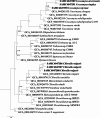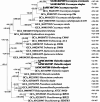Comparative genomic insights into ecological adaptations and evolutionary dynamics of Trebouxiophyceae algae
- PMID: 40836206
- PMCID: PMC12366059
- DOI: 10.1186/s12864-025-11933-y
Comparative genomic insights into ecological adaptations and evolutionary dynamics of Trebouxiophyceae algae
Abstract
Background: The Trebouxiophyceae is a diverse and species-rich class within the Chlorophyta, exhibiting a wide array of lineages and remarkable variations in morphology and ecology. This group encompasses various lifestyles, including photobionts in symbiotic relationships, free-living forms, and parasitic heterotrophs lacking photosynthetic capacity. Trebouxiophycean algae have attracted considerable scientific interest due to their fundamental biological significance and their promising applications in biotechnology. This study presents a comprehensive genomic analysis of six newly sequenced strains of Trebouxiophyceae, expanding upon a foundation of 25 previously reported high-quality genomes to conduct comparative genomics and evolutionary assessments.
Results: Molecular phylogenetic analyses based on 18 S rDNA and single-copy orthologues confirmed the accurate identification of species. The analyzed strains exhibited variable genome sizes ranging from 2.37 Mb to 106.45 Mb, with GC content varying between 46.19% and 67.20%, and repeat content ranging from 1.67 to 19.73%. Gene family expansion and contraction analyses revealed that the subaerial species Apatococcus exhibited the most extensive expansions, while Picochlorum, along with the ancestors of the parasitic genera (Auxenochlorella, Helicosporidium, and Prototheca) experienced pronounced contractions. Evolutionary analyses using the branch model and branch-site model in PAML indicated that genera with the most marked gene family expansion and contraction also contained orthogroups undergoing positive selection and rapid evolution. Comparative assessments of biosynthetic gene clusters (BGCs), nitrogen transport and assimilation proteins, hexose-proton symporter-like genes (HUP1, HUP2, and HUP3), and C4-related enzymes across 31 Trebouxiophyceae genomes revealed further patterns of adaptation. Coccomyxa was the only genus containing all the ten types of BGCs, while most other genera exhibited relatively fewer BGCs. The nitrate transporter and the urea active transporter were both absent in the three parasitic genera, and urease, the urease accessory proteins and arginase were nearly universally missing in all the species. All the species possessed the HUP1, HUP2, and HUP3 genes, except that HUP2 was absent in Prototheca and Picochlorum, and the relative abundances of the three genes varied among genera. The NAD-ME, and PCK subtypes of C4-related genes were widely distributed in all the samples, while the malate dehydrogenase (NADP+) was identified only in the four freshwater strains belonging to Chlorella and Coccomyxa.
Conclusions: Expanded gene families, along with the rapid evolution and positive selection genes, likely played important roles in environmental adaption across terrestrial and marine habitat. Conversely, genome streamlining due to widespread gene families likely contributed to the parasitic heterotrophic lifestyles. Additionally, the distribution of BGCs, nitrogen transport proteins and HUP-like genes, and the types of C4-related enzymes perhaps highlighted the potential of Trebouxiophyceae to adapt to complex and varied environmental conditions.
Keywords: Biosynthetic gene clusters (BGCs); Comprehensive genomic analysis; Evolutionary analyses; Gene family expansion and contraction; Hexose-proton symporter-like genes; Nitrogen transport and assimilation proteins; Phylogeney; Trebouxiophyceae.
© 2025. The Author(s).
Conflict of interest statement
Declarations. Competing interests: The authors declare no competing interests.
Figures





Similar articles
-
Prescription of Controlled Substances: Benefits and Risks.2025 Jul 6. In: StatPearls [Internet]. Treasure Island (FL): StatPearls Publishing; 2025 Jan–. 2025 Jul 6. In: StatPearls [Internet]. Treasure Island (FL): StatPearls Publishing; 2025 Jan–. PMID: 30726003 Free Books & Documents.
-
Complete mitochondrial genomes of the Prototheca genus: comparative genomics and evolutionary insights.BMC Genomics. 2025 Aug 21;26(1):766. doi: 10.1186/s12864-025-11952-9. BMC Genomics. 2025. PMID: 40836223 Free PMC article.
-
Comparative analysis of 18 chloroplast genomes reveals genomic diversity and evolutionary dynamics in subtribe Malaxidinae (Orchidaceae).BMC Plant Biol. 2025 Aug 2;25(1):1013. doi: 10.1186/s12870-025-06772-8. BMC Plant Biol. 2025. PMID: 40753185 Free PMC article.
-
Systemic pharmacological treatments for chronic plaque psoriasis: a network meta-analysis.Cochrane Database Syst Rev. 2021 Apr 19;4(4):CD011535. doi: 10.1002/14651858.CD011535.pub4. Cochrane Database Syst Rev. 2021. Update in: Cochrane Database Syst Rev. 2022 May 23;5:CD011535. doi: 10.1002/14651858.CD011535.pub5. PMID: 33871055 Free PMC article. Updated.
-
Systemic pharmacological treatments for chronic plaque psoriasis: a network meta-analysis.Cochrane Database Syst Rev. 2017 Dec 22;12(12):CD011535. doi: 10.1002/14651858.CD011535.pub2. Cochrane Database Syst Rev. 2017. Update in: Cochrane Database Syst Rev. 2020 Jan 9;1:CD011535. doi: 10.1002/14651858.CD011535.pub3. PMID: 29271481 Free PMC article. Updated.
References
-
- Li S, Tan H, Liu B, Zhu H, Hu Z, Liu G. Watanabeales ord. Nov. And twelve Nov.l species of Trebouxiophyceae (Chlorophyta). J Phycol. 2021;57(4):1167–86. - PubMed
-
- Friedl T. Inferring taxonomic positions, and testing genus level assignments in, coccoid green lichen algae - a phylogenetic analysis of 18S ribosomal-RNA sequences from Dictyochloropsis-reticulata and from members of the genus Myrmecia. (Chlorophyta, Trebouxiophyceae cl-nov). J Phycol. 1995;31(4):632–9.
-
- Guiry MD. How many species of algae are there? A reprise. Four kingdoms, 14 phyla, 63 classes and still growing. J Phycol. 2024;60(2):214–28. - PubMed
-
- Leliaert F, Smith DR, Moreau H, Herron MD, Verbruggen H, Delwiche CF, De Clerck O. Phylogeny and molecular evolution of the green algae. CRC Crit Rev Plant Sci. 2012;31(1):1–46.
-
- Lewis LA, McCourt RM. Green algae and the origin of land plants. Am J Bot. 2004;91(10):1535–56. - PubMed
Publication types
MeSH terms
Grants and funding
LinkOut - more resources
Full Text Sources
Miscellaneous

